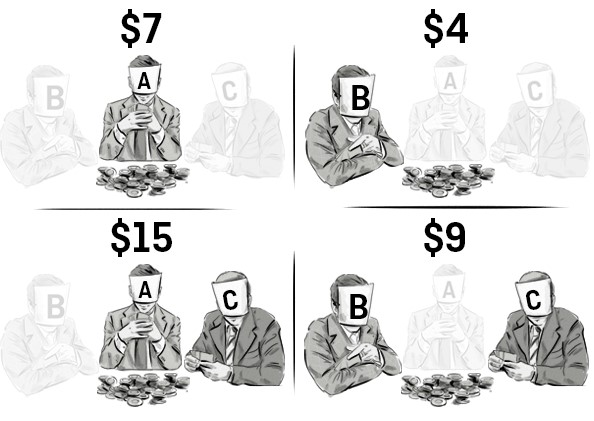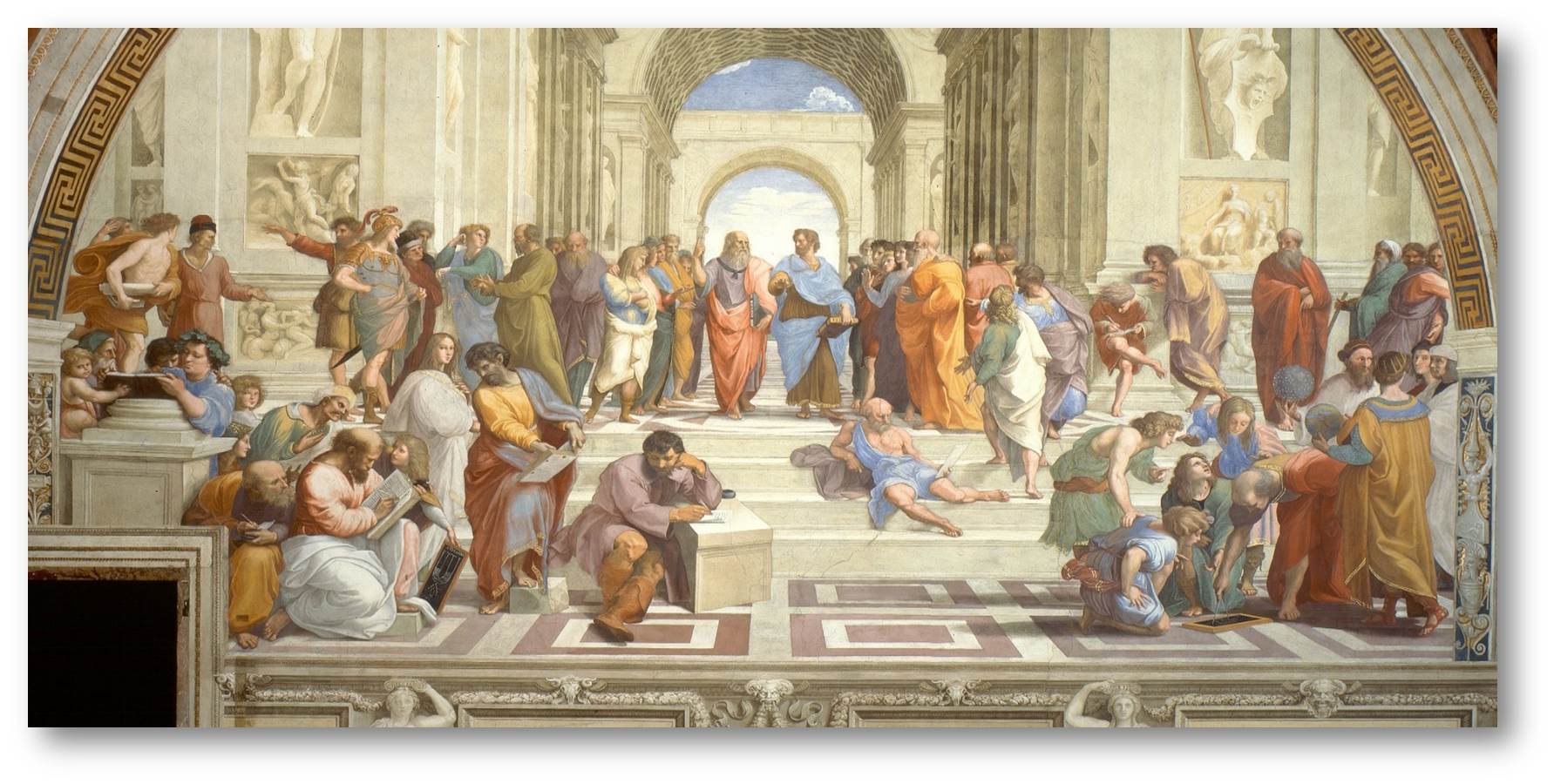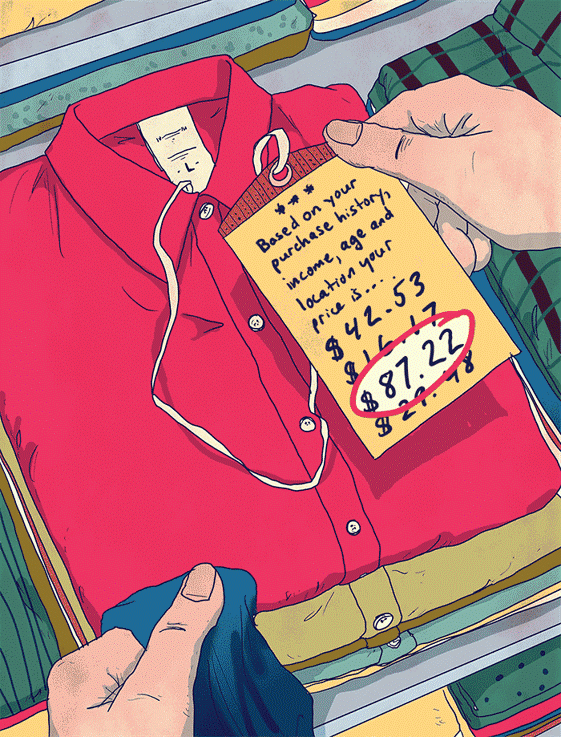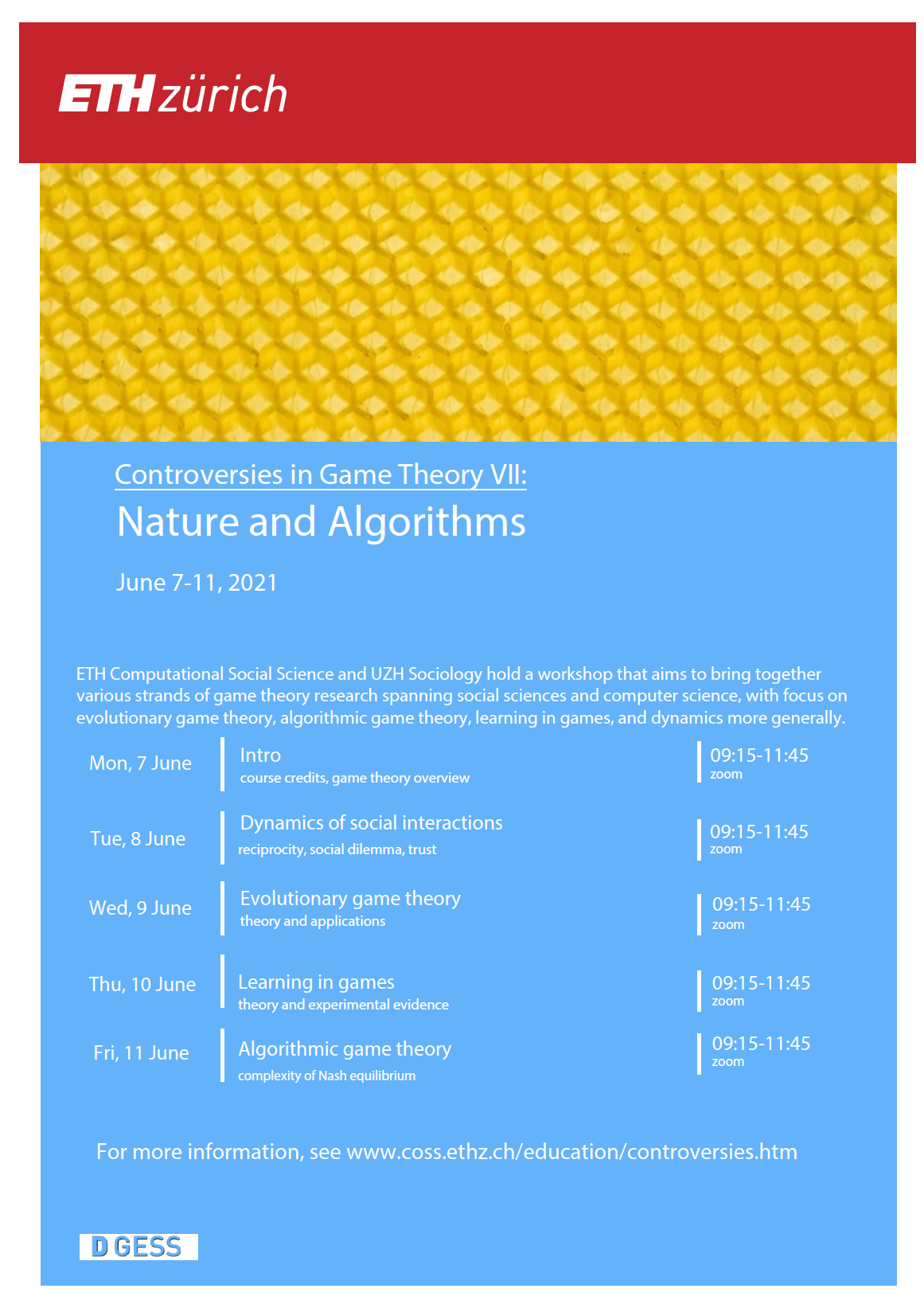
Project Details
This list of references got started and was curated by Sergiu Hart until 1999/2000. We thank him for letting us continue this job, and André Casajus for some references. For further additions and suggestions, please contact gametheory.online !
- Aarts, H. and K. Hoede [1997], "A Marginalistic Value for Monotonic Set Games," International Journal of Game Theory 26, 97-112.
- Amer, R. and F. Carreras [1995], "Games and Cooperation Indices," International Journal of Game Theory 24, 239-258.
- Amer, R. and F. Carreras [1997], "Cooperation Indices and Weighted Shapley Values," Mathematics of Operations Research 22, 955-968.
- Artstein, Z. [1971], "Values of Games with Denumerably Many Players," International Journal of Game Theory 1, 27-37.
- Aubin, J. [1981], "Cooperative Fuzzy Games," Mathematics of Operations Research 6, 1-13.
- Aumann, R. J. [1964], "Markets with a Continuum of Traders," Econometrica 32, 39-50.
- Aumann, R. J. [1975], "Values of Markets with a Continuum of Traders," Econometrica 43, 611-646.
- Aumann, R. J. [1978], "Recent Developments in the Theory of the Shapley Value," Proceedings of the International Congress of Mathematicians, Helsinki, 995-1003.
- Aumann, R. J. [1985], "An Axiomatization of the Non-Transferable Utility Value," Econometrica 53, 599-612.
- Aumann, R. J. [1985], "On the Non-Transferable Utility Value: A Comment on the Roth-Shafer Examples," Econometrica 53, 667-678.
- Aumann, R. J. [1986], "Rejoinder," Econometrica 54, 985-989.
- Aumann, R. J. [1987], "Value, Symmetry and Equal Treatment: A Comment on Scafuri and Yannelis," Econometrica 55, 1461-1464.
- Aumann, R. J. [1990], "The Shapley Value," in Game Theory and Applications, T. Ichiishi, A. Neyman and Y. Tauman (eds.), Academic Press, 158-165.
- Aumann, R. J. [1994], "The Shapley Value," in Game-Theoretic Methods in General Equilibrium Analysis, J.-F. Mertens and S. Sorin (eds.), Kluwer Academic Publishers, 61-66.
- Aumann, R. J. [1994], "Economic Applications of the Shapley Value," in Game-Theoretic Methods in General Equilibrium Analysis, J.-F. Mertens and S. Sorin (eds.), Kluwer Academic Publishers, 121-133.
- Aumann, R. J. and J. Drèze [1974], "Cooperative Games with Coalition Structures," International Journal of Game Theory 3, 217-237.
- Aumann, R. J. and J. Drèze [1986], "Values of Markets with Satiation or Fixed Prices," Econometrica 54, 1271-1318.
- Aumann, R. J., R. J. Gardner and R. W. Rosenthal [1977], "Core and Value for a Public Goods Economy: An Example," Journal of Economic Theory 15, 363-365.
- Aumann, R. J. and M. Kurz [1977], "Power and Taxes," Econometrica 45, 1137-1161.
- Aumann, R. J. and M. Kurz [1977], "Power and Taxes in a Multi-Commodity Economy," Israel Journal of Mathematics 27, 185-234.
- Aumann, R. J. and M. Kurz [1978], "Power and Taxes in a Multi-Commodity Economy (updated)," Journal of Public Economics 9, 139-161.
- Aumann, R. J., M. Kurz and A. Neyman [1983], "Voting for Public Goods," Review of Economic Studies 50, 677-693.
- Aumann, R. J., M. Kurz and A. Neyman [1987], "Power and Public Goods," Journal of Economic Theory 42, 108-127.
- Aumann, R. J. and R. B. Myerson [1988], "Endogenous Formation of Links between Players and of Coalitions: An Application of the Shapley Value," in The Shapley Value, A. E. Roth (ed.), Cambridge University Press, 175-191.
- Aumann, R. J. and U. Rothblum [1977], "Orderable Set Functions and Continuity III: Orderability and Absolute Continuity," SIAM Journal on Control and Optimization 15, 156-162.
- Aumann, R. J. and L. S. Shapley [1974], Values of Non-Atomic Games, Princeton University Press.
- Banzhaff, J. F. III [1965], "Weighted Voting Does Not Work: A Mathematical Analysis," Rutgers Law Review 19, 317-343.
- Banzhaff, J. F. III [1968], "One Man, 3.312 Votes: A Mathematical Analysis of the Electoral College," Villanova Law Review 13, 304-332.
- Beja, A. and I. Gilboa [1990], "Values for Two-Stage Games: Another View of the Shapley Axioms," International Journal of Game Theory 19, 17-32.
- Berbee, H. [1981], "On Covering Single Points by Randomly Ordered Intervals," Annals of Probability 9, 520-528.
- Bilbao, J.-M. [1998], "Values and Potential of Games with Cooperation Structure," International Journal of Game Theory 27, 131-145.
- Billera, L. J. and D. C. Heath [1982], "Allocation of Shared Cost: A Set of Axioms Yielding a Unique Procedure," Mathematics of Operations Research 7, 32-39.
- Billera, L. J., D. C. Heath and J. Raanan [1978], "Internal Telephone Billing Rates - A Novel Application of Non-Atomic Game Theory," Operations Research 26, 956-965.
- Billera, L. J., D. C. Heath and J. Raanan [1981], "A Unique Procedure for Allocating Common Costs from a Production Process," Journal of Accounting Research 19, 185-196.
- Binmore, K. [1987], "Perfect Equilibria in Bargaining Models," in The Economics of Bargaining, K. Binmore and P. Dasgupta (eds.), Blackwell, 77-105.
- Bolger, E. M. [1982], "Characterizing the Banzhaf and Shapley Values Assuming Limited Linearity," International Journal of Game Theory 11, 1-12.
- Bolger, E. M. [1989], "A Set of Axioms for a Value for Partition Function Games," International Journal of Game Theory 18, 37-44.
- Bolger, E. M. [1993], "A Value for Games with n Players and r Alternatives," International Journal of Game Theory 22, 319-334.
- Bolger, E. M. [2000], "A Consistent Value for Games with n Players and r Alternatives," International Journal of Game Theory 29, 93-99.
- Brams, S. J. [1975], Game Theory and Politics, Free Press, NY.
- Brams, S. J., P. J. Affuso and D. M. Kilgour [1989], "Presidential Power: A Game-Theoretic Analysis," in The Presidency in the American Politics, P. Brace, C. B. Harrington and G. King (eds.), New York University Press, 55-72.
- van den Brink, R. [1997], "An Axiomatization of the Disjunctive Permission Value for Games with a Permission Structure," International Journal of Game Theory 26, 27-44.
- van den Brink, R. and R. P. Gilles [1996], "Axiomatizations of the Conjunctive Permission Value for Games with Permission Structures," Games and Economic Behavior 12, 113-126.
- van den Brink, R. (2007). Null or nullifying players: the difference between the Shapley value and equal division solutions. Journal of Economic Theory, 136(1), 767-775
- Brown, D. and P. A. Loeb [1977], "The Values of Non-Standard Exchange Economies," Israel Journal of Mathematics 25, 71-86.
- Butnariu, D. [1987], "Values and Cores of Fuzzy Games With Infinitely Many Players," International Journal of Game Theory 16, 43-68.
- Butnariu, D. and E. P. Klement [1993], Triangular Norm-Based Measures and Games with Fuzzy Coalitions, Kluwer Academic Publishers.
- Butnariu, D. and E. P. Klement [1996], "Core, Value and Equilibria for Market Games: On a Problem of Aumann and Shapley," International Journal of Game Theory 25, 149-160.
- Calvo, E. and J. C. Santos [1997], "Potentials in Cooperative TU Games," Mathematical Social Science 34, 175-190.
- Calvo, E. and J. C. Santos [2000], "Weighted Weak Semivalues," International Journal of Game Theory 29, 1-9.
- Carreras, F. [1992], "Filtrations, Values and Voting Discipline," International Journal of Game Theory 20, 357-376.
- Carreras, F. [1997], "Automorphisms and Weighted Values," International Journal of Game Theory 26, 1-10.
- Casajus, A. (2009). Outside options, component efficiency, and stability. Games and Economic Behavior, 65(1), 49-61.
- Casajus, A. (2011), Differential marginality, van den Brink fairness, and the Shapley value, in: Theory and Decision 71 (2), 163-174.
- Casajus, A. (2012), Amalgamating players, symmetry, and the Banzhaf value, in: International Journal of Game Theory 41 (3), 497-515.
- Casajus, A. (2014), Collusion, quarrel, and the Banzhaf value, in: International Journal of Game Theory 43 (1), 2014, 1-11.
- Casajus, A. (2018), Symmetry, mutual dependence, and the weighted Shapley values, in: Journal of Economic Theory 178, 105-123.
- Casajus, A. (2019), Relaxations of symmetry and the weighted Shapley values, in: Economics Letters, forthcoming.
- Casajus, A., & Huettner, F. (2013). Null players, solidarity, and the egalitarian Shapley values. Journal of Mathematical Economics, 49(1), 58-61.
- Casajus, A., & Huettner, F. (2014). Weakly monotonic solutions for cooperative games. Journal of Economic Theory, 154, 162-172.
- Casajus, A., & Huettner, F. (2018), Decomposition of solutions and the Shapley value, in: Games and Economic Behavior 108, 37-48.
- Champsaur, P. [1975], "Cooperation vs. Competition," Journal of Economic Theory 11, 394-417.
- Cheng, H. [1981], "On Dual Regularity and Value Convergence Theorems," Journal of Mathematical Economics 6, 37-57.
- Chun, Y. [1989], "A New Axiomatization of the Shapley Value," Games and Economic Behavior 1, 119-130.
- Chun, Y. [1991], "On the Symmetric and Weighted Shapley Values," International Journal of Game Theory 20, 183-190.
- Coleman, J. S. [1986], Individual Interests and Collective Action: Selected Essays, Cambridge University Press.
- De Clippel, Geoffroy, and Roberto Serrano. "Marginal contributions and externalities in the value." Econometrica 76.6 (2008): 1413-1436.
- Deegan, J. and E. Packel [1979], "A New Index of Power for Simple n-Person Games," International Journal of Game Theory 7, 113-123.
- Derks, J., H. Haller and H. Peters [2000], "The Selectoscope for Cooperative Games," International Journal of Game Theory 29, 23-38.
- Derks, J. and H. Peters [1993], "A Shapley Value for Games with Restricted Coalitions," International Journal of Game Theory 21, 351-360.
- Do, K. H. P., & Norde, H. (2007). The Shapley value for partition function form games. International Game Theory Review, 9(02), 353-360.
- Driessen, T. S. H. [1985], "The t-Value, the Core and Semiconvex Games," International Journal of Game Theory 14, 219-228.
- Dubey, P. [1975], "On the Uniqueness of the Shapley Value," International Journal of Game Theory 4, 131-139.
- Dubey, P. and A. Neyman [1984], "Payoffs in Nonatomic Economies: An Axiomatic Approach," Econometrica 52, 1129-1150.
- Dubey, P. and A. Neyman [1994], "An Axiomatic Approach to the Equivalence Phenomenon," in Game-Theoretic Methods in General Equilibrium Analysis, J.-F. Mertens and S. Sorin (eds.), Kluwer Academic Publishers, 135-144.
- Dubey, P. and A. Neyman [1997], "An Equivalence Principle for Perfectly Competitive Economies," Journal of Economic Theory 75, 314-344.
- Dubey, P., A. Neyman and R. J. Weber [1981], "Value Theory without Efficiency," Mathematics of Operations Research 6, 122-128.
- Dubey, P. and L. S. Shapley [1979], "Mathematical Properties of the Banzhaf Power Index," Mathematics of Operations Research 4, 99-131.
- Einy, E. [1987], "Semivalues of Simple Games," Mathematics of Operations Research 12, 185-192.
- Einy, E. [1988], "The Shapley Value on Some Lattices of Monotonic Games," Mathematical Social Sciences 15, 1-10.
- Faigle, U. and W. Kern [1992], "The Shapley Value for Cooperative Games under Precedence Constraints," International Journal of Game Theory 21, 249-266.
- Feinberg, Y. [1998], "An Incomplete Cooperation Structure for a Voting Game Can Be Strategically Stable," Games and Economic Behavior 24, 2-9.
- Felsenthal, D. S. and M. Machover [1995], "Postulates and Paradoxes of Voting Power - A Critical Re-appraisal," Theory and Decision 38, 195-229.
- Felsenthal, D. S. and M. Machover [1996], "Alternative Forms of the Shapley Value and the Shapley-Shubik Index," Public Choice 87, 315-318.
- Felsenthal, D. S. and M. Machover [1997], "Ternary Voting Games," International Journal of Game Theory 26, 335-351.
- Felsenthal, D. S. and M. Machover [1997], "The Weighted Voting Rule in the EU Council of Ministers, 1958-1995: Intentions and Outcomes," Electoral Studies 16, 33-47.
- Felsenthal, D. S., M. Machover and W. Zwicker [1998], "The Bicameral Postulates and Indices of a priori Voting Power," Theory and Decision 44, 83-116.
- Felsenthal, D. S. and M. Machover [1998], "The Product Paradox of Voting Power," Public Choice 96, 81-92.
- Felsenthal, D. S. and M. Machover [1998], The Measurement of Voting Power: Theory and Practice, Problems and Paradoxes, Edward Elgar.
- Felsenthal, D. S. and M. Machover [1998], "Minimizing the Mean Majority Deficit: the Second Square-Root Rule," Mathematical Social Sciences 37, 25-37.
- Feltkamp, V. [1995], "Alternative Axiomatic characterizations of the Shapley and Banzhaf Values," International Journal of Game Theory 24, 179-186.
- Fogelman, F. and M. Quinzii [1980], "Asymptotic Values of Mixed Games," Mathematics of Operations Research 5, 86-93.
- Gardner, R. J. [1977], "Shapley Value and Disadvantageous Monopolies," Journal of Economic Theory 16, 513-517.
- Gardner, R. J. [1981], "Wealth and Power in a Collegiate Polity," Journal of Economic Theory 25, 353-366.
- Gardner, R. J. [1983], "l-Transfer Value and Fixed-Price Equilibrium in Two-Sided Markets," in Social Choice and Welfare, P. K. Pattanaik and M. Salles (eds.), North-Holland, 301-323.
- Gardner, R. J. [1984], "Power and Taxes in a One-Party State: The USSR, 1925-1929," International Economic Review 25, 743-755.
- Gilboa, I. and D. Monderer [1991], "Quasivalues on Subspaces of Games," International Journal of Game Theory 19, 353-363.
- Gomes, A., S. Hart and A. Mas-Colell [1999], "Finite Horizon Bargaining and the Consistent Field," Games and Economic Behavior 27, 204-228.
- Guesnerie, R. [1977], "Monopoly, Syndicate, and Shapley Value: About Some Conjectures," Journal of Economic Theory 15, 235-251.
- Gul, F. [1989], "Bargaining Foundations of Shapley Value," Econometrica 57, 81-95.
- Gul, F. [1999],"Efficiency and Immediate Agreement: A Reply to Hart and Levy," Econometrica 67, 913-915.
- Haimanko, O. [1998], "Non-Symmetric Values of Finite Games," The Hebrew University of Jerusalem, Center for Rationality DP-167.
- Haimanko, O. [1998],"Non-Symmetric Values of Non-Atomic and Mixed Games," The Hebrew University of Jerusalem, Center for Rationality DP-168.
- Haimanko, O. [1998], "Partially Symmetric Values," The Hebrew University of Jerusalem, Center for Rationality DP-169.
- Haimanko, O. [1999], "Payoffs in Non-Differentiable Perfectly Competitive Economies," The Hebrew University of Jerusalem, Center for Rationality DP-197.
- Haimanko, O. [1999], "Payoffs in Non-Differentiable Perfectly Competitive Economies," The Hebrew University of Jerusalem, Center for Rationality DP-205.
- Haller, H. [1994], "Collusion Properties of Values," International Journal of Game Theory 23, 261-282.
- Hamiache, G. [1999], "A Value with Incomplete Communication," Games and Economic Behavior 26, 59-78.
- Harsanyi, J. C. [1959], "A Bargaining Model for the Cooperative n-Person Games," in Contributions to the Theory of Games IV (Annals of Mathematics Studies 40), A. W. Tucker and R. D. Luce (eds.), Princeton University Press, 325-356.
- Harsanyi, J. C. [1963], "A Simplified Bargaining Model for the n-Person Cooperative Game," International Economic Review 4, 194-220.
- Harsanyi, J. C. [1977], Rational Behavior and Bargaining Equilibrium in Games and Social Situations, Cambridge University Press.
- Harsanyi, J. C. [1980], "Comments on Roth's Paper, 'Values for Games Without Side Payments'," Econometrica 48, 477.
- Harsanyi, J. C. [1985], "The Shapley Value and the Risk Dominance Solutions of Two Bargaining Models for Characteristic-Function Games," in Essays in Game Theory and Mathematical Economics, R. J. Aumann et al (eds.), Bibliographisches Institut Mannheim, 43-68.
- Hart, O. and J. Moore [1990], "Property Rights and the Nature of the Firm," Journal of Political Economy 98, 1119-1157.
- Hart, S. [1973], "Values of Mixed Games," International Journal of Game Theory 2, 69-85.
- Hart, S. [1976], "A Note on the Edges of the n-Cube," Discrete Mathematics 14, 157-163.
- Hart, S. [1977], "Asymptotic Value of Games with a Continuum of Players," Journal of Mathematical Economics 4, 57-80.
- Hart, S. [1977], "Values of Non-Differentiable Markets with a Continuum of Traders," Journal of Mathematical Economics 4, 103-116. Reprinted in Game and Economic Theory, S. Hart and A. Neyman (eds.), The University of Michigan Press [1995], 321-334.
- Hart, S. [1979], "Values of Large Market Games," in Applied Game Theory, S. J. Brams, A. Schotter and G. Schwödiauer (eds.), Physica-Verlag, 187-197.
- Hart, S. [1980], "Measure-Based Values of Market Games," Mathematics of Operations Research 5, 197-228.
- Hart, S. [1985], "An Axiomatization of Harsanyi's Non-Transferable Utility Solution," Econometrica 53, 1295-1313.
- Hart, S. [1985], "Non-Transferable Utility Games and Markets: Some Examples and the Harsanyi Solution," Econometrica 53, 1445-1450.
- Hart, S. [1985], "Axiomatic Approaches to Coalitional Bargaining," in Game Theoretic Models of Bargaining, A. E. Roth (ed.), Cambridge University Press, 305-319.
- Hart, S. [1987], "Shapley Value," in The New Palgrave: A Dictionary of Economics, J. Eatwell, M. Milgate and P. Newman (eds.), Macmillan Press, vol. 4, 318-320. Reprinted in Game Theory, J. Eatwell, M. Milgate and P. Newman (eds.), Macmillan Press [1989], 210-216.
- Hart, S. [1990], "Advances in Value Theory," in Game Theory and Applications, T. Ichiishi, A. Neyman and Y. Tauman (eds.), Academic Press, 166-175.
- Hart, S. [1994], "On Prize Games," in Essays in Game Theory, N. Megiddo (ed.), Springer-Verlag, 111-121.
- Hart, S. [1994], "The Harsanyi Value," in Game-Theoretic Methods in General Equilibrium Analysis, J.-F. Mertens and S. Sorin (eds.), Kluwer Academic Publishers, 105-111.
- Hart, S. [1994], "Value Equivalence Theorems: The TU and NTU Cases," in Game-Theoretic Methods in General Equilibrium Analysis, J.-F. Mertens and S. Sorin (eds.), Kluwer Academic Publishers, 113-120.
- Hart, S. [1997], "Classical Cooperative Theory II: Value-Like Solutions," in Cooperation: Game Theoretic Approaches, S. Hart and A. Mas-Colell (eds.), Springer-Verlag, 43-49.
- Hart, S. and M. Kurz [1983], "On the Endogenous Formation of Coalitions," Econometrica 51, 1295-1313.
- Hart, S. and M. Kurz [1984], "Stable Coalition Structures," in Coalitions and Collective Actions, M. J. Holler (ed.), Physica-Verlag, 235-258.
- Hart, S. and Z. Levy [1999], "Efficiency Does Not Imply Immediate Agreement," Econometrica 67, 909-912.
- Hart, S. and A. Mas-Colell [1988], "The Potential of the Shapley Value," in The Shapley Value, A. E. Roth (ed.), Cambridge University Press, 127-137.
- Hart, S. and A. Mas-Colell [1989], "Potential, Value and Consistency," Econometrica 57, 589-614.
- Hart, S. and A. Mas-Colell [1992], "A Non-Cooperative Interpretation of Value and Potential," in Rational Interaction, R. Selten (ed.), Springer-Verlag, 83-93.
- Hart, S. and A. Mas-Colell [1995], "Egalitarian Solutions of Large Games: I. A Continuum of Players," Mathematics of Operations Research 20, 959-1002.
- Hart, S. and A. Mas-Colell [1995], "Egalitarian Solutions of Large Games: II. The Asymptotic Approach," Mathematics of Operations Research 20, 1003-1022.
- Hart, S. and A. Mas-Colell [1996], "Harsanyi Values of Large Economies: Non-Equivalence to Competitive Equilibria," Games and Economic Behavior 13, 74-99.
- Hart, S. and A. Mas-Colell [1996], "Bargaining and Value," Econometrica 64, 357-380. Reprinted in Recent Developments in Game Theory, E. S. Maskin (ed.), Elgar Publishing [1999], 440-463.
- Hart, S. and D. Monderer [1997], "Potential and Weighted Values of Nonatomic Games," Mathematics of Operations Research 22, 619-630.
- Hart, S. and A. Neyman [1988], "Values of Non-Atomic Vector Measure Games: Are They Linear Combinations of the Measures?," Journal of Mathematical Economics 17, 31-40.
- Holzman, R., E. Lehrer and N. Linial [1988], "Some Bounds for the Banzhaf Index and Other Semivalues," Mathematics of Operations Research 13, 358-363.
- Hsiao, C.-R. and T. E. S. Raghavan [1992], "Monotonicity and Dummy Free Property for Multi-Choice Cooperative Games," International Journal of Game Theory 21, 301-312.
- Hsiao, C.-R. and T. E. S. Raghavan [1993], "Shapley Value for Multi-Choice Cooperative Games, I," Games and Economic Behavior 5, 240-256.
- Hsiao, C.-R. [1995], "A Value for Continuously-Many-Choice Cooperative Games," International Journal of Game Theory 24, 273-292.
- Imai, H. [1983],"Voting, Bargaining, and Factor Income Distribution," Journal of Mathematical Economics 11, 211-233.
- Imai, H. [1983], "On Harsanyi's Solution," International Journal of Game Theory 12, 161-179.
- Iñarra, E. and J. M. Usategui [1993], "The Shapley Value and Average Convex Games," International Journal of Game Theory 22, 13-30.
- Kalai, E. and D. Samet [1985], "Monotonic Solutions to General Cooperative Games," Econometrica 53, 307-327.
- Kalai, E. and D. Samet [1987], "On Weighted Shapley Values," International Journal of Game Theory 16, 205-222.
- Kannai, Y. [1966], "Values of Games with a Continuum of Players," Israel Journal of Mathematics 4, 54-58.
- Kern, R. [1985], "The Shapley Transfer Value Without Zero Weights," International Journal of game Theory 14, 73-92.
- Khmelnitskaya, A. B. [1999], "Marginalist and Efficient Values for TU Games," The Hebrew University of Jerusalem, Center for Rationality DP-188; Mathematical Social Sciences (forthcoming).
- Khmelnitskaya, A. B. [1999], "Power Indices Without the Transfer Axiom," in Logic, Game Theory and Social Choice, H. de Swart (ed.), Tilburg University Press, 208-213.
- Kleinberg, N. and J. H. Weiss [1985], "Equivalent N-Person games and the Null Space of the Shapley Value," Mathematics of Operations Research 10, 233-243.
- Kleinberg, N. and J. H. Weiss [1986], "The Orthogonal Decomposition of Games and an Averaging Formula for the Shapley Value," Mathematics of Operations Research 11, 117-124.
- Krishna, V. and R. Serrano [1995], "Perfect Equilibria of a Model of N-Person Noncooperative Bargaining," International Journal of Game Theory 24, 259-272.
- Kohlberg, E. [1973], "On Non-Atomic Games: Conditions for f °m Ì pNA," International Journal of Game Theory 2, 87-98.
- Kurz, M. [1977], "Distortion of Preferences, Income Distribution and the Case for a Linear Income Tax," Journal of Economic Theory 14, 291-298.
- Kurz, M. [1980], "Income Distribution and Distortion of Preferences: the l-Commodity Case," Journal of Economic Theory 22, 99-106.
- Lefèvre, F. [1994], "The Shapley Value of a Perfectly Competitive Market May Not Exist," in Game-Theoretic Methods in General Equilibrium Analysis, J.-F. Mertens and S. Sorin (eds.), Kluwer Academic Publishers, 95-104.
- Lehrer, E. [1988], "An Axiomatization of the Banzhaf Value," International Journal of Game Theory 17, 89-99.
- Lemaire, J. [1973], "A New Value for Games without Transferable Utilities," International Journal of Game Theory 2, 205-214.
- Leviatan, S. [1998], "Consistent Values and the Core in Continuum Market Games with Two Types," The Hebrew University of Jerusalem, Center for Rationality DP-171.
- Levy, A. and R. P. McLean [1989], "Weighted Coalition Structure Values," Games and Economic Behavior 1, 234-249.
- Levy, A. and R. P. McLean [1991], "An Axiomatization of the Weighted NTU Value," International Journal of Game Theory 19, 339-352.
- Littlechild, S. C. and G. Owen [1973], "A Simple Expression for the Shapley Value in a Special Case," Management Science 20, 99-107.
- Lucas, W. F. [1983], "Measuring Power in Weighted Voting Systems," in Political and Related Models, S. J. Brams, W. F. Lucas and P. D. Straffin (eds.), Springer-Verlag.
- Mann, I. and L. S. Shapley [1960], "Values of Large Games, IV: Evaluating the Electoral College by Monte-Carlo Techniques," The Rand Co. RM-2651-PR, Santa Monica, CA.
- Mann, I. and L. S. Shapley [1962], "Values of Large Games, VI: Evaluating the Electoral College Exactly," The Rand Co. RM-3158-PR, Santa Monica, CA.
- Macho-Stadler, I., Pérez-Castrillo, D., & Wettstein, D. (2007). Sharing the surplus: An extension of the Shapley value for environments with externalities. Journal of Economic Theory, 135(1), 339-356.
- Maschler, M. [1982], "The Worth of a Cooperative Enterprise to Each Member," in Games, Economic Dynamics and Time Series Analysis, M. Diestler, F. Fürst and G. Schwödiauer (eds.), Physica-Verlag, 67-73.
- Maschler, M. and G. Owen [1989], "The Consistent Shapley Value for Hyperplane Games," International Journal of Game Theory 18, 389-407.
- Maschler, M. and G. Owen [1992], "The Consistent Shapley Value for Games without Side Payments," in Rational Interaction, R. Selten (ed.), Springer-Verlag, 5-12.
- Maschler, M., G. Owen and B. Peleg [1988], "Paths Leading to the Nash Set," in The Shapley Value, A. E. Roth (ed.), Cambridge University Press, 321-330.
- Mas-Colell, A. [1977], "Competitive and Value Allocations of Large Exchange Economies," Journal of Economic Theory 14, 419-438.
- Mas-Colell [1980], "Remarks on the Game-Theoretic Analysis of a Simple Distribution of Surplus Problem," International Journal of Game Theory 9, 125-140.
- Mas-Colell, A. [1988], "Algunos Comentarios sobre la Teoria Cooperativa de los Juegos," Cuadernos Economicos 40, 143-161.
- Mas-Colell, A. [1997], "Bargaining Games," in Cooperation: Game Theoretic Approaches, S. Hart and A. Mas-Colell (eds.), Springer-Verlag, 43-49.
- McLean, R. P. [1991], "Random Order Coalition Structure Values," International Journal of Game Theory 20, 109-127.
- McQuillin, B. (2009). The extended and generalized Shapley value: Simultaneous consideration of coalitional externalities and coalitional structure. Journal of Economic Theory, 144(2), 696-721.
- Mertens, J.-F. [1980], "Values and Derivatives," Mathematics of Operations Research 5, 523-552.
- Mertens, J.-F. [1988], "The Shapley Value in the Non-Differentiable Case," International Journal of Game Theory 17, 1-65.
- Mertens, J.-F. [1988], "Nondifferentiable TU Markets: The Value," in The Shapley Value, A. E. Roth (ed.), Cambridge University Press, 235-264.
- Mertens, J.-F. [1994], "The TU-Value: The Non-Differentiable Case," in Game-Theoretic Methods in General Equilibrium Analysis, J.-F. Mertens and S. Sorin (eds.), Kluwer Academic Publishers, 81-94.
- Milchtaich, I. [1995], "The Value of Nonatomic Games Arising from Certain Noncooperative Congestion Games," The Hebrew University of Jerusalem, Center for Rationality DP-87.
- Milchtaich, I. [1998], "Vector Measure Games Based on Measures with Values in an Infinite Dimensional Vector Space," Games and Economic Behavior 24, 25-46.
- Milnor, J. W. and L. S. Shapley [1978], "Values of Large Games II: Oceanic Games," Mathematics of Operations Research 3, 290-307.
- Mirman, L. J. and A. Neyman [1983], "Prices for Homogeneous Cost Functions," Journal of Mathematical Economics 12, 257-273.
- Mirman, L. J. and A. Neyman [1984],"Diagonality of Cost Allocation Prices," Mathematics of Operations Research 9, 66-74.
- Mirman, L. J., J. Raanan and Y. Tauman [1982], "A Sufficient Condition on f for f°m to be in pNAD," Journal of Mathematical Economics 9, 251-257.
- Mirman, L. J., D. Samet and Y. Tauman [1983], "An Axiomatic Approach to the Allocation of Fixed Cost through Prices," Bell Journal of Economics 14, 139-151.
- Mirman, L. J. and Y. Tauman [1982], "The Continuity of the Aumann-Shapley Price Mechanism," Journal of Mathematical Economics 9, 235-249.
- Mirman, L. J. and Y. Tauman [1982], "Demand Compatible Equitable Cost-Sharing Prices," Mathematics of Operations Research 7, 40-56.
- Monderer, D. [1986], "Measure Based Values of Non-Atomic Games," Mathematics of Operations Research 11, 321-335.
- Monderer, D. [1988], "A Probabilistic Problem Arising in Economics," Journal of Mathematical Economics 17, 321-338.
- Monderer, D. [1988], "Values and Semivalues on Subspaces of Finite Games," International Journal of Game Theory 17, 321-338.
- Monderer, D. [1989], "Asymptotic Measure Based Values of Nonatomic Games," Mathematics of Operations Research 14, 737-744.
- Monderer, D. [1989], "Weighted Majority Games Have Many m-Values," International Journal of Game Theory 18, 321-325.
- Monderer, D. [1990], "A Milnor Condition for Non-Atomic Lipschitz Games and its Applications," Mathematics of Operations Research 15, 714-723.
- Monderer, D. and A. Neyman [1988], "Values of Smooth Nonatomic Games: The Method of Multilinear Approximation," in The Shapley Value, A. E. Roth (ed.), Cambridge University Press, 217-234.
- Monderer, D., D. Samet and L. S. Shapley [1992], "Weighted Shapley Values and the Core," International Journal of Game Theory 21, 27-39.
- Monderer, D. and W. H. Ruckle [1990], "On the Symmetry Axiom for Values of Non-Atomic Games," International Journal Mathematics and Mathematical Sciences 13, 165-170.
- Myerson, R. B. [1976], "Values of Games in Partition Function Form," International Journal of Game Theory 6, 23-31.
- Myerson, R. B. [1977], "Graphs and Cooperation in Games," Mathematics of Operations Research 2, 225-229.
- Myerson, R. B. [1980], "Conference Structures and Fair Allocation Rules," International Journal of Game Theory 9, 169-182.
- Myerson, R. B. [1992], "Fictitious-Transfer Solutions in Cooperative Game Theory," in Rational Interaction, R. Selten (ed.), Springer-Verlag, 13-33.
- Nash, J. [1950], "The Bargaining Problem," Econometrica 18, 155-162.
- Nax, H. H., & Pradelski, B. S. (2015). Evolutionary dynamics and equitable core selection in assignment games. International Journal of Game Theory, 44(4), 903-932.
- Neyman, A. [1977], "Continuous Values are Diagonal," Mathematics of Operations Research 2, 338-342.
- Neyman, A. [1977], "Values for Non-Transferable Utility Games with a Continuum of Players," Cornell University, S.O.R.I.E. TR-351.
- Neyman, A. [1979], "Asymptotic Values of Mixed Games," in Game Theory and Related Topics, O. Moeschlin and D. Pallaschke (eds.), North-Holland, 71-81.
- Neyman, A. [1981], "Singular Games Have Asymptotic Values," Mathematics of Operations Research 6, 205-212.
- Neyman, A. [1982], "Renewal Theory for Sampling without Replacement," Annals of Probability 10, 464-481.
- Neyman, A. [1985], "Semi-Values of Political Economic Games," Mathematics of Operations Research 10, 390-402.
- Neyman, A. [1988], "Weighted Majority Games Have Asymptotic Values," Mathematics of Operations Research 13, 556-580.
- Neyman, A. [1989], "Uniqueness of the Shapley Value," Games and Economic Behavior 1, 116-118.
- Neyman, A. [1994], "Values of Games with a Continuum of Players," in Game-Theoretic Methods in General Equilibrium Analysis, J.-F. Mertens and S. Sorin (eds.), Kluwer Academic Publishers, 67-79.
- Neyman, A. [1998], "Values of Non-Atomic Vector Measure Games," The Hebrew University of Jerusalem, Center for Rationality DP-183.
- Neyman, A. and Y. Tauman [1976], "The Existence of Nondiagonal Axiomatic Values," Mathematics of Operations Research 1, 246-250.
- Neyman, A. and Y. Tauman [1979], "The Partition Value," Mathematics of Operations Research 4, 236-264.
- Nowak, A. S. [1997], "Note on the Axiomatization of the Banzhaf Value without the Additivity Axiom," International Journal of Game Theory 26, 137-146.
- Nowak, A. S. and T. Radzik [1994], "A Solidarity Value for n-Person Transferable Utility Games," International Journal of Game Theory 23, 261-282.
- Nowak, A. S. and T. Radzik [1994], "The Shapley Value for n-Person Games in Generalized Characteristic Function Form," Games and Economic Behavior 6, 150-161.
- Nowak, A. S. and T. Radzik [1995], "On Axiomatizations of the Weighted Shapley Values," Games and Economic Behavior 8, 389-405.
- Orshan, G. [1992], "The Consistent Shapley Value in Hyperplane Games from a Global Standpoint," International Journal of Game Theory 21, 1-12.
- Osborne, M. J. [1984], "Why Do Some Goods Bear Higher Taxes than Others?," Journal of Economic Theory 32, 301-316.
- Otten, G.-J., P. Borm and S. Tijs [1996], "A Note on the Characterizations of the Compromise Value," International Journal of Game Theory 25, 427-436.
- Owen, G. [1968], "A Note on the Shapley Value," Management Science 14, 731-732.
- Owen, G. [1971], "Political Games," Naval Research Logistics Quarterly 18, 345-355.
- Owen, G. [1972], "Multilinear Extensions of Games," Management Science 18, 64-79.
- Owen, G. [1972], "A Value for Games Without Side Payments," International Journal of Game Theory 1, 95-109.
- Owen, G. [1975], "Evaluation of a Presidential Election Game," American Political Science Review 69, 947-953.
- Owen, G. [1977], "Values of Games with a priori Unions," in Essays in Mathematical Economics and Game Theory, R. Henn and O. Moeschlin (eds.), Springer-Verlag, 76-88.
- Owen, G. [1986], "Values of Graph-Restricted Games," SIAM Journal of Algebra and Discrete Mathematics 7, 210-220.
- Owen, G. [1994], "The Non-Consistency and Non-Uniqueness of the Inductive Value," in Essays in Game Theory, N. Megiddo (ed.), Springer-Verlag, 155-162.
- Owen, G. and L. S. Shapley [1989], "Optimal Location of Candidates in Ideological Space," International Journal of Game Theory 18, 339-356.
- Owen, G. and E. Winter [1992], "The Multilinear Extension and the Coalition Value," Games and Economic Behavior 4, 582-587.
- Pallaschke, D. and J. Rosenmüller [1995], "The Shapley Value for Countably Many Players," University of Bielefeld, Institute of Mathematical Economics WP-240.
- Pechersky, S. and A. Sobolev [1995], "Set-Valued Nonlinear Analogues of the Shapley Value," International Journal of Game Theory 24, 57-78.
- Peck, R. M. [1986], "Power and Linear Income Taxation: An Example," Econometrica 54, 87-94.
- Peck, R. M. [1988], "Power, Majority Voting and Linear Income Tax Schedules," Journal of Public Economics 36, 53-67.
- Perez-Castrillo, D. and D. Wettstein [1999], "Bidding for the Surplus: A Non-Cooperative Approach to the Shapley Value," Ben-Gurion University, Monaster Center for Economic Research DP 99-7.
- Riker, W. and L. S. Shapley [1968], "Weighted Voting: A Mathematical Analysis for Instrumental Judgements," in Representation: Nomos X, J. R. Pennock and J. W. Chapman (eds.), Atherton, 199-216.
- Rosenmüller, J. [1977], "Remark on the Transfer Operator and the Value-Equilibrium Equivalence Hypothesis," in Mathematical Economics and Game Theory, R. Henn and O. Moeschlin (eds.), Springer-Verlag, 108-127.
- Rosenmüller, J. [1981], "Values of Non-Sidepayment Games and Their Application in the Theory of Public Goods," in Essays in Game Theory and Mathematical Economics, R. J. Aumann et al (eds.), Bibliographisches Institut Mannheim, 111-129.
- Rosenmüller, J. [1984], "Selection of Values for Non-Sidepayment Games," Methods of Operations Research 48, 339-398.
- Rosenthal, R.W. [1976], "Lindahl Solutions and Values for a Public Goods Example," Journal of Mathematical Economics 3, 37-41.
- Rosenthal, R.W. [1990], "Monotonicity of the Core and Value in Dynamic Cooperative Games," International Journal of Game Theory 19, 45-58.
- Roth, A. E. [1977], "The Shapley Value as a von Neumann-Morgenstern Utility," Econometrica 45, 657-664.
- Roth, A. E. [1980], "Values of Games without Side Payments: Some Difficulties with Current Concepts," Econometrica 48, 457-465.
- Roth, A. E. [1986], "On the Non-Transferable Utility Value: A Reply to Aumann," Econometrica 54, 981-984.
- Roth, A. E. (ed.) [1988], The Shapley Value, Cambridge University Press.
- Rothblum, U. [1973], "On Orderable Set Functions and Continuity I," Israel Journal of Mathematics 16, 375-397.
- Rothblum, U. [1977], "Orderable Set Functions and Continuity II: Set Functions with Infinitely Many Null Points," SIAM Journal on Control and Optimization 15, 144-155.
- Ruckle, W. H. [1982], "Projections in Certain Spaces of Set Functions," Mathematics of Operations Research 7, 314-318.
- Ruckle, W. H. [1982], "An Extension of the Aumann-Shapley Value Concept to Functions on Arbitrary Banach Spaces," International Journal of Game Theory 11, 105-116.
- Ruiz, L. M., F. Valenciano and J. M. Zarzuelo [1998], "The Family of Least Squares Values for Transferable Utility Games," Games and Economic Behavior 24, 109-130.
- Samet, D., Y. Tauman and I. Zang [1984], "An Application of the Aumann-Shapley Prices to the Transportation Problems," Mathematics of Operations Research 9, 25-42.
- Santos, J. C. and J. M. Zarzuelo [1998], "Mixing Weighted Values of Non-Atomic Games," International Journal of Game Theory 27, 331-342.
- Scafuri, A. J. and N. Yannelis [1984], "Non-Symmetric Cardinal Value Allocations," Econometrica 52, 1365-1368.
- Serrano, R. (2007). Cooperative games: Core and Shapley value (No. 2007-11). Working Paper, Brown University, Department of Economics.
- Shafer, W. [1980], "On the Existence and Interpretation of Value Allocations," Econometrica 48, 467-477.
- Shapiro, N. Z. and L. S. Shapley [1978], "Values of Large Games I: A Limit Theorem," Mathematics of Operations Research 3, 1-9.
- Shapley, L. S. [1953], "Additive and Non-Additive Set Functions," Ph.D. thesis, Princeton University.
- Shapley, L. S. [1953], "A Value for n-Person Games," in Contributions to the Theory of Games II (Annals of Mathematics Studies 28), H. W. Kuhn and A. W. Tucker (eds.), Princeton University Press, 307-317.
- Shapley, L. S. [1962], "Values of Games with Infinitely Many Players," in Recent Advances in Game Theory, M. Maschler (ed.), Ivy Curtis Press, Philadelphia, 113-118; also The Rand Co. RM-2912, Santa Monica, CA.
- Shapley, L. S. [1964], "Values of Large Games VII: A General Exchange Economy with Money," The Rand Co. RM-4248-PR, Santa Monica, CA.
- Shapley, L. S. [1969], "Utility Comparison and the Theory of Games," in La Décision, Editions du CNRS, Paris, 251-263.
- Shapley, L. S. [1977], "A Comparison of Power Indices and a Nonsymmetric Generalization," The Rand Co. P-5872, Santa Monica, CA.
- Shapley, L. S. [1981], "Discussant's Comments on R. D. Banker's 'Equity Considerations in Traditional Full Cost Allocation Practices: An Axiomatic Perspective'," in Joint Cost Allocations, S. Moriarty (ed.), University of Oklahoma Press, 131-136.
- Shapley, L. S. and M. Shubik [1954], "A Method for Evaluating the Distribution of Power in a Committee System," American Political Science Review 48, 787-792.
- Shapley, L. S. and M. Shubik [1969], "Pure Competition, Coalitional Power, and Fair Division," International Economic Review 24, 1-39.
- Sroka, J. J. [1993], "The Value of Certain pNA Games through Infinite-Dimensional Banach Spaces," International Journal of Game Theory 22, 123-139.
- Straffin, P. D. [1977], "Homogeneity, Independence and Power Indices," Public Choice 30, 107-118.
- Straffin, P. D. [1994], "Power and Stability in Politics," Hanbook of Game Theory with Economic Applications, Vol. II, R. J. Aumann and S. Hart (eds.), North-Holland, 1127-1151.
- Straffin, P. D. and J. P. Heaney [1981], "Game Theory and the Tennessee Valley Authority," International Journal of Game Theory 10, 35-43.
- Suzuki, M. and M. Nakayama [1976], "The Cost Assignment of Cooperative Water Resource Development: A Game Theoretic Approach," Management Science 22, 1081-1086.
- Tauman, Y. [1977], "A Nondiagonal Value on a Reproducing Space," Mathematics of Operations Research 2, 331-337.
- Tauman, Y. [1979], "Value on the Space of all Scalar Integrable Games," in Game Theory and Related Topics, O. Moeschlin and D. Pallaschke (eds.), North-Holland, 107-115.
- Tauman, Y. [1981], "Value on a Class of Non-Differentiable Market Games," International Journal of Game Theory 10, 155-162.
- Tauman, Y. [1981], "Values of Market Games with a Majority Rule," in Game Theory and Mathematical Economics, O. Moeschlin and D. Pallaschke (eds.), North-Holland, 103-122.
- Tauman, Y. [1982], "A Characterization of Vector Measures Games in pNA," Israel Journal of Mathematics 43, 75-96.
- Thomson, W. [1988], "The Manipulability of the Shapley Value," International Journal of Game Theory 17, 101-128.
- Ui, T. [2000], "A Shapley Value Representation of Potential Games," Games and Economic Behavior 31, 121-135.
- Weber, R. J. [1988], "Probabilistic Values for Games," in The Shapley Value, A. E. Roth (ed.), Cambridge University Press.
- Willson, S. J. [1993], "A Value for Partially Defined Cooperative Games," International Journal of Game Theory 21, 371-384.
- Winter, E. [1989], "A Value for Games with Level Structures," International Journal of Game Theory 18, 227-242.
- Winter, E. [1991], "A Solution for Non-Transferable Utility Games with Coalition Structure," International Journal of Game Theory 20, 53-63.
- Winter, E. [1992], "The Consistency and the Potential for Values with Games with Coalition Structure," Games and Economic Behavior 4, 132-144.
- Winter, E. [1994], "The Demand Commitment Bargaining and Snowballing Cooperation," Economic Theory 4, 255-273.
- Wooders, M. [1994], "Large Games and Economies with Effective Small Groups," in Game-Theoretic Methods in General Equilibrium Analysis, J.-F. Mertens and S. Sorin (eds.), Kluwer Academic Publishers, 145-206.
- Wooders, M. and W. R. Zame [1987], "Large Games: Fair and Stable Outcomes," Journal of Economic Theory 42, 59-93.
- Wooders, M. and W. R. Zame [1987], "NTU Values of Large Games," Stanford University, I.M.S.S.S. TR-503.
- Young, H. P. [1985], "Monotonic Solutions of Cooperative Games," International Journal of Game Theory 14, 65-72.
- Young, H. P. (ed.) [1985], Cost Allocation: Methods, Principles, Applications, North-Holland.
- Young, H. P. [1994], "Cost Allocation," in Handbook of Game Theory with Economic Applications, Vol. II, R. J. Aumann and S. Hart (eds.), North-Holland, 1193-1235.
- Documents Download the documents related to this project here
- Category Lecture materials










